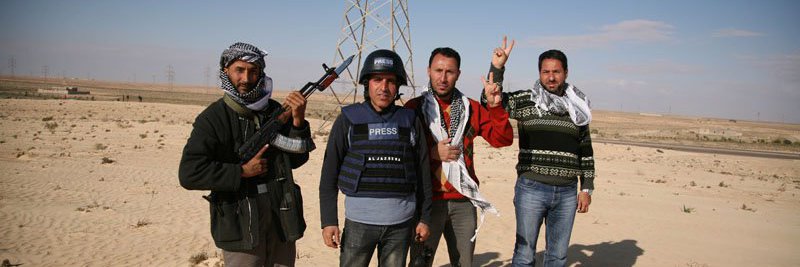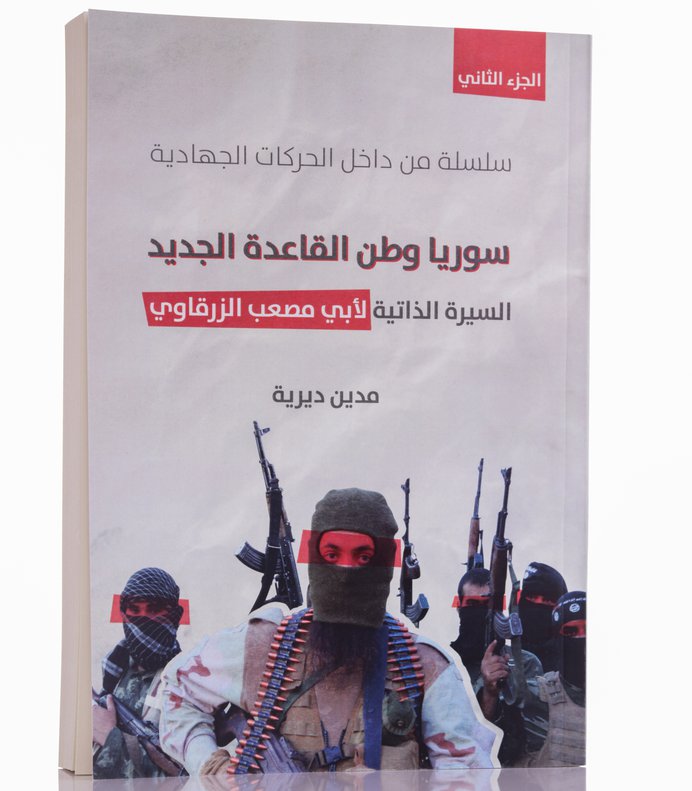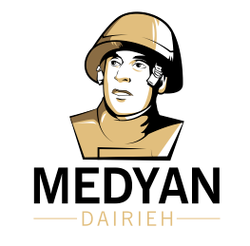Syria: Al Qaeda’s New Home - Biography of Abu Musab al-Zarqawi


FROM INSIDE THE JIHADIST MOVEMENTS
Syria: Al Qaeda’s New Home - Biography of Abu Musab al-Zarqawi
The book “Syria: Al-Qaeda’s New Home - Biography of Abu Musab Al-Zarqawi” by journalist and filmmaker Medyan Dairieh analyses the Al-Qaeda organisation especially since its inception in Syria in the 1990s and its developments throughout the Syrian revolution. The book includes and provides evidence of the author’s exclusive meetings with senior leaders of the Al-Nusra Front and of all the other jihadist movements in Syria. In the book Dairieh sheds light on the very first leaders of the Al-Qaeda organisation and narrates the most important events in the life of Abu Musab Al-Zarqawi, including his founding of the al-Qaeda organisation in Syria and his establishment of the nucleus of an Islamic State in Iraq. The facts and data described in the book are corroborated by videos and photos taken by the author during his meetings with jihadist leaders and fighters in several countries, such as Afghanistan, Somalia, Libya, Syria, Iraq, Yemen, and Lebanon. The book has been published in the Arabic language and is the second volume of the series “From Inside the Jihadist Movements” by Medyan Dairieh.
If you are interested in purchasing one or more copies of the books please email us at: books@medyandairieh.com
Journalist and filmmaker Medyan Dairieh has gathered a massive amount of information that he found on the ground in several countries over an extended number of years. He has used this information in order to write the three parts of the series “From Inside the Jihadist Movements”. During a long period, he conducted numerous exclusive interviews which have provided the basic material for a list of unique and complex reports and investigations on Jihadist movements. His research has also led to the disclosure of confidential documents, revelations, photos, videos, and letters closely related to the leaders of these organizations, and which are all being published for the first time. In the second volume of the series “Syria: Al-Qaeda’s New Home - Biography of Abu Musab Al-Zarqawi”, the author takes a deep look inside the Al Qaeda organisation and the Jihadist movements in Syria.
In the process of writing the book, the author has relied on rare documents and unique interviews with leaders, fighters, and with their families, as well as with ordinary people living under the rule of Jihadist movements. These interviews were conducted in more than fifteen countries around the world over the last sixteen years. Countries included were Afghanistan, Somalia, Libya, Syria, Iraq, Yemen, and the Ain Al-Hilweh Palestinian refugee camp in Lebanon. The interviews are corroborated by photographs that have been released for the first time.
The book also reveals unique information that appears for the first time about Abu Musab Al-Zarqawi and the first Al-Qaeda leaders and is substantiated by rare documents and photos of them. The author provides an exhaustive narration of the story of Abu Musab and his founding of the Al-Qaeda organization in Syria; he brings together the most relevant events in Abu Musab’s life and how he was able to establish what he had been seeking, the nucleus of an Islamic state, as well as his attempts to expand it. The author weaves a comprehensive story about Abu Musab’s character, from the material he gathered from testimonies and extraordinary encounters with his wives, children, close friends, and leaders within his inner circle.
The book does not only discuss concepts and strategies of the Al-Qaeda organization in Syria, but it also goes back to the date of its establishment in the country in the 1990s. The creation of Al-Qaeda is written about at great length, as are significant details about its most important members which are supported by documents and photos. Perhaps one of the most striking aspects examined is a report published for the first time about one of the first Al-Qaeda members to arrange suicide car bomb explosions and suicide bombings. The person in question did play a major role in suicide attacks in Iraq and was considered an expert and an instructor in making explosives, from Herat in Afghanistan up to Fallujah in Iraq.
The book sheds light on the hidden signs that many missed at that time, and how the regimes in Syria and of Saddam Hussein in Iraq at the very least turned a blind eye on the movements of Jihadists and Al-Qaeda’s operatives and on how these Jihadists could easily shift between the two states. And it also points out how Iran also resonated with that approach and shared with the regimes in Syria and Iraq the policy of turning a blind eye to the movements of Al-Qaeda’s leaders and members among the three countries in the post-Soviet period.
Then the author resumes his description of Al-Qaeda in Syria, and how it gradually developed in a new and different way following the outbreak of the events of the revolution in the country, starting with the formation of the Al-Nusra Front, with the author meeting many of its leaders and documenting his interviews with photos and videos. The author was the first journalist ever to meet with the leaders of the Al-Nusra Front, events which he narrates in detail in the book. He then proceeds to relate the encounters he had with the rest of the local and foreign Jihadist movements in Syria as he met their leaders and members and held long conversations with them which he documented in the pages of his book. The author was also the first journalist to meet with a number of foreign fighters, encounters that are also corroborated by photos and videos.
In this book, Medyan Dairieh examines the most important paradoxes which arose from the outbreak of the Arab revolutions, as he recounts the stories of these revolutions from the beginning, and how, at first, they were about streets and squares full of peaceful demonstrators raising their voice to call for the fall of the regimes. And then he proceeds to explain how, even before the dust had settled, these revolutions had turned into bloody conflicts, civil wars, and counter-revolutions. The author also illustrates how the West and its allies strongly backed these revolutions and counter-revolutions.
Then the author takes us back to the period of the Afghan Jihad against the Soviets and the emergence of the phenomenon of the Afghan-Arabs, who were also supported by the West and their allies, in an apparent paradox exposed by the author between the lines. And he lays in the hands of the readers this unique material, leaving them to think and to form their own view on the subject as he delineates a resemblance between the Afghan Jihad and Jihad in Syria at the time of the ongoing war. He also leaves the readership to analyse the position of each actor in this matter, starting from the West and its allies, then the Russians and Iranians, thirdly the Jihadists, and fourthly those actors behind the scenes.
Through the book's lines we are reminded of the Arab Jihad in Afghanistan, and of how many resistance groups and movements, most of them Islamic, were established with great support from the West and the Muslim world. Saudi Arabia, the Gulf states, and Egypt were at the forefront of supporting the Afghan Jihad politically, through the media and financially, while also providing equipment and weapons. Besides that, there was aid delivered by social, civil, religious, educational, and relief organizations, in addition to the press and the media propping up the Afghan Jihad against the Soviets. Moreover, religious institutions, with Al-Azhar at the forefront, played a prominent role in stirring and mobilizing, with Imams ascending the pulpit of mosques to urge Jihad and issuing fatwas forbidding any relation with the Soviets.
And the irony that the author exposes is that after the outbreak of the Arab Spring revolutions, media institutions were set up and spread everywhere, strongly supported by Western and Arab states. And that was particularly the case following the Syrian uprising. Major figures from the Arab media and media consultants from the major satellite channels contributed to the process by backing the conflict and relying on inflammatory propaganda through the institutions in which they worked, while completing their task through social media blogging.
Following the Arab Spring revolutions, a wide network of Arab media organizations was established with huge budgets. Television channels, newspapers and news websites were launched in light of the rivalry between Qatar, Saudi Arabia, and the United Arab Emirates over contracts for deals with prestigious western channels and newspapers, the most important of which were Sky News Arabic, the Independent Arabia, and the HuffPost Arabi. These countries’ competition also led to the launching of new satellite channels and news websites such as Al-Araby, The New Arab, Al-Ghad, and Al-Ghad Al-Arabi, while former Al-Jazeera journalist Ghassan bin Jiddo founded the pro-Iranian and pro-Syrian Al-Mayadeen channel.
At the same time, radical religious discourse had begun to escalate with clerics using mosques and media organizations to convey their ideas. Many clerics ruled that Jihad in Syria had become an individual duty upon every Muslim, and these fatwas drove thousands of young Muslims to join Jihad in Syria. And that was for the same reason that groups of Muslim youths had felt compelled to go and fight in Afghanistan against the Soviets.
In parallel with the unprecedented attention of the media towards the events of the Syrian revolution, Arab and Western capitals, as well as Turkey and Jordan, witnessed intense political activity. Major hotels hosted both secret and public conferences. Political and even financial deals were struck, while names, programs and projects were provided for the post-Assad period. Moreover, a vast and complex network of relief, humanitarian, civil, political, social, women’s, cultural, and religious organizations, as well as youth and children's movements, were formed as the basis for an alternative government to that of Syrian President Bashar Al-Assad.
And the puzzling question is that after all these bloody battles and a protracted fierce war in Syria, President Al-Assad retains his power and this remains an issue for further debates. Moreover, the fact that a number of Arab states and specifically the Gulf states are reopening their embassies in Damascus to resume diplomatic relations with Syria, strengthens the continuation of President Bashar Al-Assad's rule and ends the likelihood of him losing power.
The author then leaves the readers to view and scrutinize the chapters themselves and to answer the several questions he posed in his book, the most important of which is: was there a repeat of the same strategy, with the Jihadists being used in the war on terror? And this time in Syria, in the midst of ideological fighting against the second main enemies of the West and the Arab regimes: Iran and Lebanese Hezbollah. Are the Americans, the West and their Arab allies winning again in Syria the way they won the proxy war against the Soviets in Afghanistan? Will these powers allow any victory to be scored by the Russians, the Iranians and their allies?
How convinced is the public opinion about the sincerity of these states and governments’ real will to oust President Bashar Al-Assad and to help the masses of the Syrian Revolution?! What these states and governments have done is throw a life buoy to the regime of President Bashar Al-Assad after the heat of the Arab masses’ uprisings had begun to reach the regimes that these countries strongly support? Who is responsible for prolonging the conflict? And why did Syria become an arena of competition and confrontation between the major powers and their external opponents?!
All these arguments and data need to be analysed and scrutinized carefully and then followed by open discussions. Is it important to re-examine events that happened at an earlier stage and link them to the current ones by means of historical comparisons? Do those past events reflect what we are currently experiencing?!
The most important question remains: what are the similarities and differences between what happened during the Jihad against the Russians in Afghanistan and the bloody conflict in Syria?! Is the Syrian civil war a mirroring of the Afghan paradigm in the fighting against the Russians?!!

